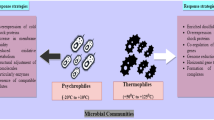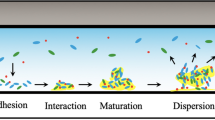Summary
It is proposed that the grouping of unicellular forms of bacteria into clusters or colonies may be the first step in the evolution of multicellular forms and that any further evolutionary advance would require the subordination of the impulses of the individual in favour of the needs of the “colony”. This latter relationship is exemplified by the group movement of certain aerobic sporeforming bacilli. A description of the nature of this movement on the surface of nutrient agar has been made.
Studies on 54 strains showing this group movement reveal that they taxonomically constitute a nebulous group in Morphological Group II of the genus Bacillus according to the presently accepted system of classification (Bergey's Manual 1957). While the large majority of the strains studied morphologically resemble B. alvei, none exhibit the typical physiological characteristics of this species. Considering all the characteristics studied, the strains in our collection could be placed in an indefinite group comprising B. alvei, B. circulans, B. laterosporus and B. pulvifaciens. This however does not reflect any marked dissimilarities between the strains studied but rather the unsatisfactory taxonomy of the species enumerated. A re-examination of the determinative classification of these four species especially with reference to the unsatisfactory use of starch hydrolysis in the key to the genus is suggested.
Similar content being viewed by others
References
Baker, H., H. Sobotka and S. H. Hutner: Growth requirements of some thermophilic and mesophilic bacilli. J. gen. Microbiol. 9, 485 (1953).
Bonner, J. T.: A descriptive study of the development of the slime mold Dictyostelium discoideum. Amer. J. Bot. 31, 175 (1944).
Bonner, J. T.: The pattern of differentiation in amoeboid slime molds. Amer. Natural. 86, 79 (1952).
Breed, R. S., E. G. D. Murray and N. R. Smith: Bergey's Manual of Determinative Bacteriology. Baltimore: Williams and Wilkins Co. 1957.
Eigelsbach, H. T., W. Braun and R. D. Herring: Studies on the variation of Bacterium tularense. J. Bact. 61, 557 (1951).
Hugh, R., and E. Leifson: The taxonomic significance of fermentative versus oxidative metabolism of carbohydrates by various Gram negative bacteria. J. Bact. 66, 24 (1953).
Iyer, V., and J. V. Bhat: Observations on the taxonomy of the genus Bacillus. Arch. Mikrobiol. 23, 88 (1955).
Kanga, D. H.: Studies on the growth and sporulation of sporeforming bacilli in defined media. M. Sc. thesis, Gujarat University.
Kanga, D. H., and V. Iyer: Interrelationships between amino acids in the growth of Bacillus subtilis. J. Sci. industr. Res. 18 C, 85 (1959).
Katznelson, H., and A. G. Lochhead: Nutritional requirements of Bacillus alvei and Bacillus para-alvei. J. Bact. 53, 83 (1947).
Khambata, S. R.: Studies on some microorganisms associated with the intestine of the Indian earthworm Ph. D. thesis, University of Bombay (1954).
Knight, B. C. J. G.: The principles of Microbial Classification. Nutritional characters. J. gen. Microbiol. 12, 348 (1955).
Loeffler, F.: Zbl. Bakt. 7, 625 (1890).
Murray, R. G. E., and R. H. Elder: The predominance of counter-clock wise rotation during swarming of Bacillus species. J. Bact. 58, 351 (1949).
Raper, K. B.: Developmental patterns in simple slime molds. Growth (3rd symposium) 5, 41 (1941).
Sasarman, A., V. Ganea and M. Dospina: Contribution to the study of motility of bacterial colonies. Arch. Roumaines Path. exp. Microbiol. 16 (3), 395 (1957).
Robinow, C. F.: A study of the nuclear apparatus of bacteria. Proc. roy. Soc. B 130, 299 (1942).
Shaw, C., and P. H. Clarke: Biochemical classification of Proteus and Providence cultures. J. gen. Microbiol. 13, 155 (1955).
Shinn, L. E.: A cinematographic analysis of motion of Bacillus alvei. J. Bact. 36, 419 (1938).
Shinn, L. E.: The motion of colonies of Bacillus alvei as shown by lapse-time cinematography. J. Bact. 39, 22 (1940).
Smith, N. R., R. E. Gordon and F. E. Clarke: Aerobic Sporeforming Bacteria. Agriculture Monograph No. 16, U. S. Dept. of Agriculture, Washington, D. C. (1952).
Society of American Bacteriologists: Manual of Microbiological Methods. New York: McGraw Hill Book Co., 1957.
Sussman, M.: ‘Fruity’ and other mutants of the cellular slime mould, Dictyostelium discoideum: a study of developmental aberrations. J. gen. Microbiol. 13, 295 (1955).
Sussman, M., and R. R. Sussman: 14th symposium for the study of Growth and Development. Princeton: Princeton Univ. Press 1957.
Author information
Authors and Affiliations
Additional information
With 3 Figures in the Text
Rights and permissions
About this article
Cite this article
Shukla, J.S., Iyer, V.N. Aerobic sporeforming bacilli showing the phenomenon of colony migration. Archiv. Mikrobiol. 39, 298–312 (1961). https://doi.org/10.1007/BF00439526
Received:
Issue Date:
DOI: https://doi.org/10.1007/BF00439526




